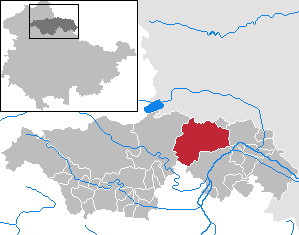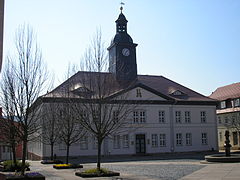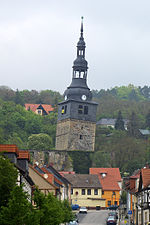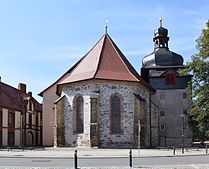Bad Frankenhausen / Kyffhäuser
| coat of arms | Germany map | |
|---|---|---|

|
Coordinates: 51 ° 21 ' N , 11 ° 6' E |
|
| Basic data | ||
| State : | Thuringia | |
| County : | Kyffhäuserkreis | |
| Height : | 132 m above sea level NHN | |
| Area : | 91.07 km 2 | |
| Residents: | 10,139 (Dec. 31, 2019) | |
| Population density : | 111 inhabitants per km 2 | |
| Postal code : | 06567 | |
| Area code : | 034671 | |
| License plate : | KYF, ART, SDH | |
| Community key : | 16 0 65 003 | |
| LOCODE : | DE BFK | |
| City structure: | 6 districts | |
City administration address : |
Markt 1, 06567 Bad Frankenhausen / Kyffhäuser |
|
| Website : | ||
| Mayor : | Matthias Strejc ( SPD ) | |
| Location of the city of Bad Frankenhausen / Kyffhäuser in the Kyffhäuserkreis | ||
Bad Frankenhausen / Kyffhäuser is a spa town in the Kyffhäuserkreis in Thuringia . The small town has about 10,000 inhabitants.
geography
The small town is located on the southern slope of the Kyffhäuser Mountains , on sediments of the Zechstein, at an altitude between 130 and 190 m above sea level. NN , above the loess-covered Diamantenen Aue . The Zechstein underground also contains potash and rock salts. 250 tons of rock salt were produced daily in the Frankenhausen saltworks .
City structure
The districts of Esperstedt (in the east), Ichstedt (in the northeast), Ringleben (in the east), Seehausen (in the south) and Udersleben (in the northeast) belong to Bad Frankenhausen .
history
Prehistoric time
The first settlements in the flood plain between Kyffhäuser and Hainleite about 10,000 years ago have been proven by excavations . With the Kattenburg , the residents protected themselves about two kilometers northwest of Frankenhausen on the southern edge of the Kyffhäuser Mountains in emergencies.
One of the most remarkable prehistoric cult sites in Thuringia, the Schuchard caves on the Kosackenberg, is located about two kilometers northwest of the city. This sacrificial site was used over four prehistoric epochs from the Neolithic to the older Iron Age . The offerings were deposited in hard to reach crevices. Around 1950 the caves were examined archaeologically.
Franconian settlement period until the beginning of the early modern period
The place Frankenhausen is mentioned for the first time in the 9th century in documents from the Fulda monastery as a Franconian settlement. The moated castle Frankenhausen stood in the southeast of the lower town and secured the town from the foreland. It is assumed that a fortified Franconian court (Franconhus) took the place before, because the court was mentioned in a royal charter in 998. Remains of the castle have been preserved in the terrace construction of the following castle. The residential tower with an integrated round tower of the upper castle, called Hausmannsturm , was cleverly integrated into the city wall. This upper castle is said to have been built in the 12th century. The salt springs should be secured with the castle.
Since the 11th century, the rule was under the Weimar-Orlamünde family , and the Counts of Beichlingen had ruled from the beginning of the 13th century . In 1340, the Count of Schwarzburg acquired the town, which had been granted city rights since 1282. Due to the division of inheritance, Frankenhausen became the seat of the Schwarzburg-Frankenhausen line from 1571 to 1594 . In 1599 the rule came to the Counts of Schwarzburg-Rudolstadt by inheritance and until 1918 it became the capital of the sub-rule of the Principality of Schwarzburg-Rudolstadt, last known as the District Office district .
Scene of the German Peasant War
In 1525, the battle of Frankenhausen took place on the so-called Schlachtberg on the northern edge of the city as the last great battle of the German Peasants' War . The revolutionary theologian Thomas Müntzer was the spiritual leader and priestly support of the peasants and was taken prisoner after their defeat. The farmers suffered 6,000 deaths. The way up to the Schlachtberg is still called the “blood channel” today. The so-called Peasants' War Panorama , created from 1976 to 1989, recalls the events.
17th to 19th century

In 1650, the inclination of the tower of the upper church, built in the 14th century, was mentioned for the first time. In 1701 the first button makers settled in Frankenhausen. In 1799 Wilhelm Gottlieb Manniske opened the first hospital. 1818 the first spa was built Manniskes in which since 998 used for salt extraction Solquelle was used for medicinal purposes. In 1831 the first factory for mother-of-pearl buttons was founded by August Zierfuß , thus creating a basis for further industrial development. At that time the city had about 4200 inhabitants. In 1879 Minna Hankel opened the first children's health home for scrofulous children on the Kleine Wipper.
In 1896 the Kyffhäuser Technikum - polytechnic institute for training in agricultural and electrical engineering was opened, where a first lecture on aircraft construction was given in 1908 by its director, Professor Sigmund Huppert (1871–1945). The technical center was initially independent and temporarily trained up to 600 students from many countries and different religions. Financial difficulties led to the takeover by the city in 1932, and it lasted until 1946. At the end of the 19th century the city received a rail connection , first to Bretleben in 1894 and to Sondershausen in 1898 . With the railway connection, the brine spa - in wooden bath tubs - got a boost.
20th and 21st centuries
On April 5, 1927, the city was officially named Bad Frankenhausen (Kyffh.) . In 1938 the first saltwater swimming pool in Thuringia was opened there. In the mid-1930s, iron rings were placed around the leaning tower of the upper church and anchored to the nave. The Dresden statics professor Georg Rüth , who died in the bombing raids on Dresden in 1945 , made a particular contribution to this work .
During the time of National Socialism , disabled people were accommodated in the Wilhelmstift . In 1940 50 and in 1941 another 35 were taken away as part of the euthanasia killing program . In 1970 the city had a memorial stone erected in Napptal in memory of the Jews deported to the eastern extermination camps . During the Second World War , hundreds of prisoners of war as well as women and men from the occupied countries had to do forced labor on the Georg Gremels state estate, in the rose mill, with master shoemaker Th. Wachsmuth , in the precision engineering workshops Rusch & Co. and on farms in Udersleben . 17 people who died as a result of forced labor were later reburied in Sondershausen . Only one grave in the cemetery on Uderslebener Weg reminds of them.
When the American troops of the 52nd Infantry Regiment AIB (Armor Infantry Battalion), 9th Armored Division ("Ready Rifles") , Company C, under the command of Captain Samuel S. Wortham, approached Bad Frankenhausen on April 11, 1945, a US- Tank hit by a Volkssturmmann's bazooka and Commander Wortham seriously wounded. Thereupon fourteen Volkssturm men were shot while fighting, fleeing or trying to surrender. They rest in a common grave laid out on April 18 in the city's cemetery, together with eight fallen soldiers and four dead deserters who were later bedded down.
At the beginning of July 1945 the US troops surrendered the city, like all of Thuringia, to the Red Army . This made Bad Frankenhausen part of the SBZ and, from 1949, the GDR .
In 1972 Bad Frankenhausen became a garrison town . In the local, in 1968 originally for the NVA built Kyffhäuser barracks the location Medical Center Bad Frankenhausen, which were after 1990 Logistics Battalion 131, the mechanized infantry battalion 381, the tank battalion 383 and the partially active associations Infantry Battalion 382 and Tank Battalion 384 stationed.
In the 1980s, many houses like those on the Anger were in need of renovation. The Thuringian court was closed and fell into disrepair.
A typical GDR feature of the 70s and 80s are the “West antennas” for receiving “ West TV ”. "West antennas" were used to designate TV antennas that were primarily used to receive the West German programs ARD and ZDF . If the reception conditions for the television stations were reasonably favorable, then there were sometimes lots of such antennas on the roofs. These Yagi antennas were aimed at the Söhrewald transmission tower south of Kassel. The tower stands at a height of 485 m and is 148 m high. The straight line distance to Bad Frankenhausen-Bornstraße is 105 km. The antennas shown in the 1982 photo were owned by numerous directors in front of the dipole and were called Langyagi antennas. This provided good reception conditions in almost all weather conditions.
The GDR era (1949–1990) has otherwise left little traces in the city, apart from the usual signs of decay on the old buildings in the town center; the vacant lots have now been largely closed with true-to-scale architecture.
After the fall of the Wall , another Upper Church Association was founded to stabilize the tower.
In 1998 the Kyffhäuser Therme was opened.
With the suspension of traffic on the Kyffhäuserbahn between Bretleben and Sondershausen, the city lost its rail connection in December 2006.
In 2007 the city was awarded the title Sole - Heilbad .
Incorporations
On December 1st, 2007 Esperstedt with its 648 inhabitants was incorporated into Bad Frankenhausen. On January 1, 2019, Ichstedt and Ringleben were incorporated into Bad Frankenhausen from the dissolved administrative community Mittelzentrum Artern .
Population development since 1994
Development of the population (December 31) :
|
|
|
|
|
politics
City council
After the local elections on May 26, 2019 with a voter turnout of 56.2%, the Frankenhausen City Council is composed as follows:
| Local elections 2019 | ||||||
|---|---|---|---|---|---|---|
| Party / list | CDU | left | SPD | ProF * | GfBF ** | total |
| Seats | 5 seats | 4 seats | 9 seats | 3 seats | 3 seats | 24 seats |
| Share of votes | 21.3% | 16.5% | 35.9% | 13.3% | 13.0% | 100% |
| Turnout: 56.2% | ||||||
| For comparison: 2014 local elections | ||||||
| Party / list | CDU | left | SPD | ProF * | NPD | total |
| Seats | 6 seats | 4 seats | 8 seats | 1 seat | 1 seat | 20 seats |
| Share of votes | 28.5% | 21.3% | 39.3% | 6.4% | 4.5% | 100% |
| Turnout: 48.9% | ||||||
| For comparison: 2009 local elections | ||||||
| Party / list | CDU | left | SPD | ProF * | - | total |
| Seats | 5 seats | 4 seats | 9 seats | 2 seats | - | 20 seats |
| Share of votes | 22.5% | 20.2% | 46.1% | 11.2% | - | 100% |
| Turnout: 48.4% | ||||||
* Pro Frankenhausen ** Together for Bad Frankenhausen
coat of arms
Blazon : “In red, a golden castle with a wide gate tower and two small wall towers, the gold-knobbed roofs with gold-red stripes; the main tower with an open gate and a raised portcullis above the archway ; a blue sign with a golden lion floating in the gate opening. "
The coat of arms of Bad Frankenhausen can already be seen in this form on the oldest SIGILLVM CIVITATIS FRANKENHUSENSIS on a document from 1384. The Schwarzburger lion keeps the memory of the Schwarzburg rule alive. After Frankenhausen had been part of the Counts of Beichling for about 130 years, the Counts of Beichlingen of both lines sold Frankenhausen, d. H. Castle and town with all accessories and justice , to Count Günther XXI. and Heinrich XII. to Schwarzburg . The purchase price was 6,500 marks of soldered silver from Erfurt.
Town twinning
The city has had a partnership with Bad Sooden-Allendorf since 1990 .
economy
Bad Frankenhausen was previously known for its button industry. Small industry is currently predominant. But the focus is on tourism. Not only the Kyffhäuser Mountains with their forests, but above all the brine springs are a prerequisite for an intensive spa in Bad Frankenhausen.
The KMG clinics operate with the Manniske Hospital an acute hospital, which until 1994 the district Artern as a carrier and by 2019 the DRC-profit Hospital Corporation of Thuringia mbH Brandenburg possessed. There is also the Rehabilitation Center Bad Frankenhausen as a facility of the German Federal Pension Insurance and the Rehabilitation Clinic at Kyffhäuser for children and adolescents (sponsor: Klinik GmbH & Co. Sophienheilstätte KG).
The airfield Bad Frankenhausen is located three kilometers east of Bad Frankenhausen.
In addition to the spa and tourism businesses, the Bundeswehr in the Kyffhäuser barracks outside the city is an important employer in the region.
education
Forestry apprentices were trained in the Rathsfeld district during the GDR era. Today the building is used as a youth forest home and also serves as a forest adventure school.
In Bad Frankenhausen, Am Anger, there was the Robert Uhrig Secondary School . The school had a linguistic and a scientific branch of education. In the Bahnhofstrasse, separate boarding school buildings accommodated boys and girls who came from surrounding villages. There was also the Thomas Müntzer Polytechnic High School in the building of the former Citizens' School in Klosterstraße and the Juri Gagarin Polytechnic High School.
Today there are four state schools
- two elementary schools (Bad Frankenhausen, Udersleben), the elementary school of the city of Bad Frankenhausen moved to the renovated building of the former special needs school in Feldstrasse at the beginning of the school year and is now called Kurstadt-Grundschule.
- a regular school (Juri-Gagarin-Schule Bad Frankenhausen). The school was extensively renovated in the 2000s.
- a grammar school (Kyffhäusergymnasium Bad Frankenhausen) in the building of the former community school and the former POS "Thomas Müntzer". For the grammar school, the Kyffhäuserkreis is planning a new building in Bahnhofstrasse immediately adjacent to the Zweifelder sports hall, which was built in the 1990s. In addition to the school building, the construction of a cafeteria as a multi-purpose hall is also planned.
- as well as an independent vocational school (Kyffhäuser-Paracelsus-Schule Bad Frankenhausen)
Culture and sights
- The Panorama Museum Bad Frankenhausen with the monumental peasant war panorama painting by Werner Tübke (opened in 1989) is located in a striking rotunda on the Schlachtberg on the northern edge of the city .
- A special feature is the tower of the upper church built in the 14th century (Our Lady of the Mountains) , which has been tilting for centuries due to geological processes . The Elisabeth spring flows 25 meters below the tower. The tip is now at 4.60 meters outside the perpendicular . The tower thus has the greatest inclination - in meters - of all towers in Germany. Since the fall of the Wall, 1.3 million euros have gone into its renovation. The roof of the nave was on the grounds of a dry rot removed -Befalls 1962 since it is a ruin.
- The Romanesque old town church, also known as St. Petri Church, is located in Alte Kirchgasse . The ruin (supplemented with a western half-timbered porch) is interpreted as part of a three-aisled basilica that was never completed, the choir room with apse was retained. In the apse dome, frescoes with scenes of the Last Judgment created in the 14th century are shown, but these were changed in the 19th century by the church painter Wernicke, who enriched the mural with the originally non-existent “hell scene” on the right edge of the picture. The last renovation took place in 1996.
- The Frankenhausen castle of the princes of Schwarzburg-Rudolstadt emerged from the so-called lower castle. It houses the regional museum.
- The Hausmannsturm from the 13th century, once part of the so-called Oberburg, is integrated into the former city fortifications and another landmark of the city.
- Near Franconia Hausen are the Barbarossahöhle and Kyffhäuserdenkmal - they brought Bad Frankenhausen nicknamed Barbarossa city a
- Kyffhäuser Therme (3.5% brine )
- The cemetery of the former Jewish community in a wooded area in the Napptal was destroyed by the National Socialists in 1933. In the mid-1970s, the city council had a memorial stone erected there.
- The theater - and performance - Collective Drama Zone was founded in Bad Frankenhausen and here has its production headquarters.
- The lower church was built from 1691 to 1701 on the site of a monastery church from 1215.
- The city lies on the Lutherweg .
- The Unstrut-Werra cycle path also runs through the city.
Personalities
sons and daughters of the town
- Erasmus Rothmaler the Younger (1599–1662), Lutheran clergyman and neo-Latin poet in Prussia
- Johann Rothmaler (1601–1650), theologian and clergyman, later superintendent of Frankenhausen
- Johann Elias Rothmaler (1634–1694), Lutheran clergyman and alchemist
- Johann Melchior Steinbrück (1673–1723), the first inspector of the Meissen porcelain factory , designed the “ Chur swords ” as a trademark
- Johann Friedrich Müldener (1715–1766), city counsel, lawyer and chronicler
- Ludwig Friedrich von Beulwitz (1726–1796), lawyer
- Justus Friedrich Wilhelm Zachariae (1726–1777), writer, professor of poetry at the Collegium Carolinum in Braunschweig
- August Wilhelm Gottlieb Manniske (1769–1835), doctor, physicist, Fürstlich-Schwarzburg-Rudolstadt councilor
- Karl August Rüdiger (1793–1869), classical philologist and educator
- Ernst Gottfried Hornung (1795–1862), pharmacist, botanist and entomologist (steppe cress " Hornungia " was named after him)
- Andreas August Zierfuß (1804–1867), founder of the button trade and manufacturer, manufacturer of mother-of-pearl buttons
- Robert Herman Foerderer (1860–1903), from 1901 to 1903 American Congressman from Pennsylvania
- Selmar Schönland (1860–1940), botanist, researcher of flora in southern Africa
- Franz Winter (1860–1920), first social democratic president of a German state parliament
- Rudolf Aderhold (1865–1907), botanist, secret councilor, director of the Imperial Institute for Agriculture and Forestry in Berlin-Dahlem
- Wilhelm Apel (1873–1960), politician (SPD) and district administrator of the Main-Taunus district
- Hugo L. Braune (1875–?), Painter
- Wilhelm Alverdes (1896–1980), garden architect
- Hermann Rübesamen (1892–1916), chess composer
- Doris Schade (1924–2012), actress
- Tom Schilling (* 1928 in Esperstedt) is a German choreographer for modern dance theater.
- Gerhard Wolf (* 1928), writer and publisher
- Rainer Kerndl (1928–2018), writer and theater critic
- Hans-Dieter Döpmann (1929–2012), church historian
- Günther Gassmann (1931–2017), Evangelical Lutheran theologian
- Peter Petrel (* 1940), singer
- Harald Vollmar (* 1947), marksman and multiple Olympic medalist
- Reimund Neugebauer (* 1953), engineer and university professor, 10th President of the Fraunhofer Society
- Kersten Steinke (* 1958), member of the German Bundestag (Left Party)
- Jens Cotta (* 1972), member of the state parliament (AfD)
- Nils Schumann (* 1978), athlete and Olympic champion
- Dapayk (* 1978), producer and label operator
- Eva Padberg (* 1980), model
- Christopher Handke (* 1989), soccer player
- Carsten Kammlott (* 1990), soccer player
Other personalities
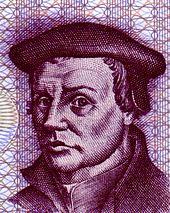
- Thomas Müntzer (1489–1525), theologian and peasant leader in the peasant war
- Johann Thölde (1565–1614), alchemist and saltworks specialist, councilor and Pfannherr in Frankenhausen
- Sethus Calvisius (1556–1615), composer, went to school in Frankenhausen
- Philipp Ernst Förster (1618–1658), civil servant, at times Syndicus von Frankenhausen
- Johann Hoffmann (1644–1718), Protestant hymn poet and teacher, rector of the Frankenhausen school
- Johann Arnold Zeitfuchs (1671–1742), theologian and writer, went to school in Frankenhausen
- August Wilhelm Reinhart (1696–1770), pastor in Frankenhausen
- Julius Strobel (1814–1884), organ builder, lived in Frankenhausen from 1842
- Anna Ritter (1865–1921), writer, lived for some time in Frankenhausen
- Leonhard Schrickel (1876–1931), writer, died in Frankenhausen
- Alfred Berg (1876–1945), teacher, founding director of the Kreisheimatmuseum
- Fritz Brather (1880–1945), director of the secondary school and writer 1916–1945
- Carl Wilhelm Witterstätter (1883–1964), aviation pioneer, lecturer at the technical center in Frankenhausen
- Hermann Groine (1897–1941), politician (NSDAP), studied at the technical college in Frankenhausen
- Alf Teichs (1904–1992), film producer, at times director of the Thomas Müntzer Festival in Frankenhausen
- Martin Gottfried Weiß (1905–1946), SS-Obersturmbannführer and concentration camp commandant , studied electrical engineering at the technical center in Frankenhausen
- Ludwig Elsbett (1913–2003), inventor, studied at the Technikum in Frankenhausen
- Werner Tübke (1929–2004), painter and graphic artist, creator of the Peasant War Panorama in Bad Frankenhausen
- Christa Wolf (1929–2011), writer, Abitur in Bad Frankenhausen (1949)
- Susanne Melior (* 1958), politician (SPD), worked in the hospital in Bad Frankenhausen between 1984 and 1986
- Uwe Mundlos (1973–2011), terrorist and alleged serial killer, was from 1994 to 1995 basic military service in the Kyffhäuser barracks in Bad Frankenhausen
literature
- Franckenhaussen in the Topographia Superioris Saxoniae ( Matthäus Merian ), Frankfurt am Main 1650, p. 82.
- Franckenhausen. In: Johann Heinrich Zedler : Large complete universal lexicon of all sciences and arts . Volume 9, Leipzig 1735, column 1704-1706.
- Liselotte Pflaumbaum: Contribution to the Franconian town history . In: Kreisheimatmuseum Bad Frankenhausen (Hrsg.): Publications of the Kreisheimatmuseum Bad Frankenhausen . Issue 1. Möbius printing works (Artern), Bad Frankenhausen 1977, p. 50 .
- Heinz Stoob : Bad Frankenhausen. City map. German city atlas. Volume 4. Part volume 2. Acta Collegii Historiae Urbanae Societatis Historicorum Internationalis. Series C. GSV Städteatlas Verlag, Dortmund-Altenbeken 1989, ISBN 3-89115-032-6 .
- Claus Peter Müller: The Pisa Test. In Bad Frankenhausen the church tower leans dangerously. Almost everyone wants to keep the Leaning Tower of Thuringia . In: FAZ , February 15, 2011.
Web links
Individual evidence
- ^ Population of the municipalities from the Thuringian State Office for Statistics ( help on this ).
- ↑ Michael Köhler: Thuringian castles and fortified prehistoric and early historical living spaces. Jenzig-Verlag, 2001, ISBN 3-910141-43-9 , p. 153.
- ↑ Michael Köhler: Pagan sanctuaries. Jenzig-Verlag, 2007, ISBN 978-3-910141-85-8 , pp. 190-192.
- ↑ Michael Köhler: Thuringian castles and fortified prehistoric and early historical living spaces. Jenzig-Verlag, 2001, ISBN 3-910141-43-9 , pp. 102 and 130.
- ^ Gerhard Köbler : Historical Lexicon of the German Lands. The German territories from the Middle Ages to the present. 7th, completely revised edition. CH Beck, Munich 2007, ISBN 978-3-406-54986-1 , p. 648.
- ↑ Volker Klimpel : Minna Hankel. In: Hubert Kolling (Ed.): Biographical lexicon on nursing history “Who was who in nursing history” . Volume 4. Elsevier, Munich 2008, pp. 131 + 132.
- ↑ Tabular overview of the history on the city's website; accessed on November 22, 2018.
- ↑ Prof. Ing.Sigmund Huppert - a Jewish university lecturer between teaching and anti-Semitism 1902 to 1931, information on the website of the Regional Museum Bad Frankenhausen, accessed on November 23, 2018.
- ↑ The “Kyffhäuser Technikum” - melting pot of religions . Information on the website of the Regional Museum Bad Frankenhausen; accessed on November 23, 2018.
- ↑ Hans Joachim Kessler: Healing water and bubbling springs. Encounters with historical baths in Thuringia . Ed .: Sparkassen-Kulturstiftung Hessen-Thüringen. E. Reinhold Verlag, Altenburg 2001, ISBN 3-910166-44-X , Bad Frankenhausen, p. 61-69 .
- ^ Andreas Weigelt: Death sentences of Soviet military tribunals against Germans (1944–1947) . Vandenhoeck & Ruprecht, Göttingen 2015, p. 195 .
- ↑ Thuringian Association of the Persecuted of the Nazi Regime - Association of Antifascists and Study Group of German Resistance 1933–1945 (Ed.): Local history guide to sites of resistance and persecution 1933–1945 . In: Heimatgeschichtliche Wegweiser . Volume 8: Thuringia . Erfurt 2003, ISBN 3-88864-343-0 , p. 167 f.
- ^ After action report, 52nd Armored Infantry Battalion, 9th Armored Division, 20 Oct 44 thru 8 May 45, 1–30, April 1945 (PDF) US Army, Combined Arms Research Library Digital Library, p. 42 (English).
- ^ Ingrid Mansel, Bad Frankenhausen: The fateful days of our city - end of the war in 1945 .
- ↑ Jürgen Möller: The fight for northern Thuringia in April 1945 . Rockstuhl-Verlag, Bad Langensalza 2010, ISBN 978-3-86777-212-9 , pp. 118-120.
- ↑ Area changes from January 1 to December 31, 2007 (year) ( XLS ; 364 kB) Destatis.de
- ↑ Thuringian Law and Ordinance Gazette , No. 14/2018 (PDF) accessed on May 20, 2019
- ^ Thuringian State Office for Statistics. Retrieved July 17, 2020 .
- ↑ 2019 municipal council elections in Thuringia - final result for Bad Frankenhausen / Kyffhäuser , accessed on October 24, 2019
- ^ New Thuringian Wappenbuch Volume 2, page 23; Publisher: Arbeitsgemeinschaft Thüringen e. V. 1998, ISBN 3-9804487-2-X .
- ^ Rathsfeld Youth Forest Home . Retrieved April 4, 2017.
- ↑ School portrait - Thuringian school portal. In: schulportal-thueringen.de. Retrieved June 15, 2016 .
- ↑ Old Town Church. In: Kyffnet.de. Retrieved July 12, 2012 .
- ^ Ingrid Scheuermann, Katja Hofmann: Funding projects of the German Foundation for Monument Protection . Ed .: German Foundation for Monument Protection. tape 1 (sacred buildings). Monuments, Bonn 2012, ISBN 3-935208-10-3 , p. 313 .

